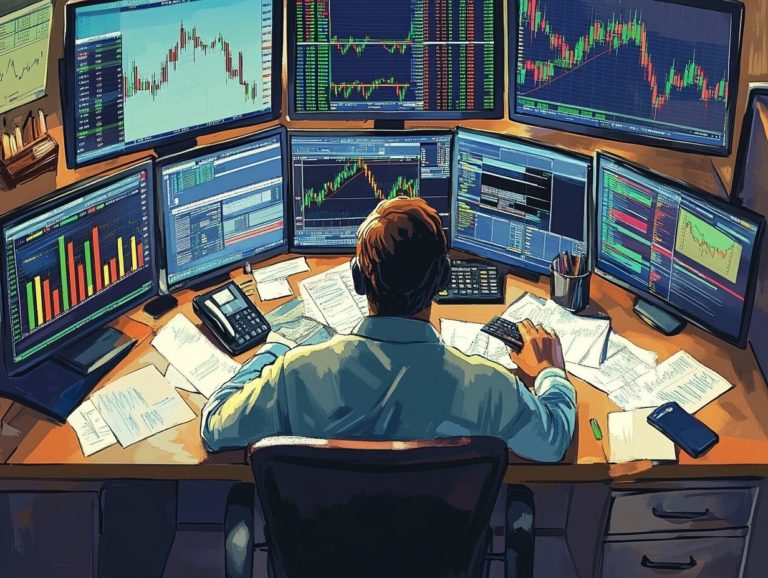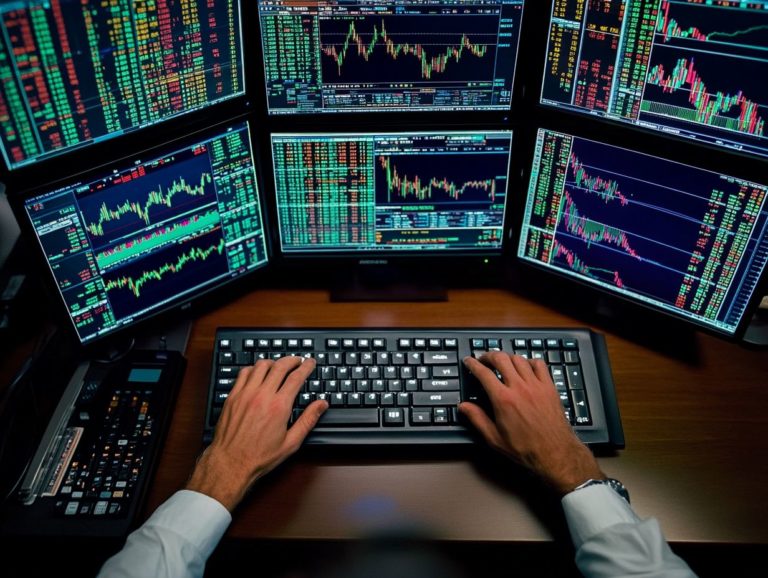What is a Stock Market Crash?
Stock market crashes can instill a deep sense of dread in investors, often resulting in substantial financial losses and a cloud of uncertainty.
Grasping the underlying causes of these abrupt downturns is essential for anyone participating in the market. This article provides a clear definition of stock market crashes, showcases historical instances and their repercussions, and pinpoints the warning signs that a crash may be looming.
It also outlines effective strategies for preparing for and recovering from these chaotic events, empowering you to protect your investments and navigate the intricate landscape of the stock market with assurance.
Contents
- Key Takeaways:
- Understanding Stock Market Crashes
- Historical Examples of Stock Market Crashes
- Major Crashes and Their Impact
- Signs of a Looming Stock Market Crash
- How to Prepare for a Stock Market Crash
- Recovering from a Stock Market Crash
- Frequently Asked Questions
- What is a Stock Market Crash?
- What causes a Stock Market Crash?
- What is the difference between a Stock Market Crash and a Market Correction?
- How does a Stock Market Crash affect the economy?
- What should I do if there is a Stock Market Crash?
- How long does it take for the stock market to recover from a crash?
Key Takeaways:

- A stock market crash is a sudden and severe drop in the overall value of the stock market, usually caused by economic or financial factors.
- Historical examples of stock market crashes, such as the Great Depression and the dot-com bubble, serve as reminders of the potential impact on the economy and investors.
- Signs of a looming stock market crash include high levels of volatility, overvalued stocks, and worrying economic signs like high unemployment rates.
Understanding Stock Market Crashes
Understanding stock market crashes is crucial for anyone involved in the market. These events often represent a sudden plummet in stock prices, typically triggered by panic selling, unsettling economic indicators, or unexpected external shocks.
Such downturns can drastically impact your investments and have profound implications for financial markets and the broader economy. Historical instances, like the 1929 Great Depression and Black Monday in 1987, serve as stark reminders of the consequences of these crashes.
They underscore the importance of robust risk management strategies, which are essential for safeguarding your investments against potential economic turmoil.
Definition and Causes
A stock market crash is marked by a sudden and often dramatic decline in stock prices, typically fueled by factors like investor panic, economic instability, and significant drops in stock indices.
This unsettling phenomenon can be ignited by a myriad of elements, including computer programs that buy and sell stocks quickly that react almost instantaneously to market shifts, ultimately leading to pronounced sell-offs.
Economic bubbles those unsustainable surges in asset prices can burst, unleashing widespread financial chaos.
You ll also find that behavioral finance plays a pivotal role here; psychological factors, such as herd mentality, can prompt investors to make hasty decisions, which only heightens market volatility. Historical instances serve as poignant reminders of this reality.
Take the 1929 crash, for example, where fear precipitated mass selling, or the 2008 financial crisis, where a wave of irrational exuberance swiftly morphed into panic in just a matter of days.
Historical Examples of Stock Market Crashes
Historical examples of stock market crashes, such as the 1929 Great Depression, Black Monday in 1987, and the COVID-19 pandemic, offer invaluable insights into the patterns and consequences of these financial upheavals.
Each of these events profoundly affected stock market values, reshaping investor behavior and leading to shifts in trading strategies and market regulations. By studying these events, you’ll gain valuable insights into the complexities of market dynamics and the importance of resilience in investment practices.
Major Crashes and Their Impact

Major crashes in the stock market have extensive repercussions on the financial landscape. They shape trading trends and can lead to trading halts or curbs to curb panic selling.
Such tumultuous events can trigger a domino effect throughout the economy. They influence everything from consumer confidence to small business investments. You may notice the ripple effect reaching across various sectors as companies grapple with fluctuating stock prices and investors become increasingly cautious.
Investor emotions play a pivotal role during these downturns. Fear can overshadow rational decision-making, leading to widespread panic that intensifies the situation. The Great Recession is a stark reminder of how interconnected these influences can be, reshaping market behaviors and investor sentiment. This compels analysts to dive deeper into the psychology behind financial decision-making and explore what truly drives investors in uncertain times.
Signs of a Looming Stock Market Crash
Recognizing the signs of an impending stock market crash is essential for you as an investor. By doing so, you can protect your portfolio. Pay close attention to indicators like rising market volatility, troubling economic signals, and atypical trading activity. These factors serve as valuable warnings, alerting you to potential declines on the horizon.
Indicators and Warning Signs
Key indicators of a stock market crash include heightened market volatility, rising margin debt levels, and signs of a speculative bubble. These elements can trigger investor panic and lead to sudden declines.
Understanding these indicators helps elevate your trading strategies. For instance, when you notice increased volatility, analyze whether this trend aligns with external economic factors. Such fluctuations often act as warning signals for larger downturns.
Rising margin debt levels can indicate an unsustainable borrowing environment. Many investors may be over-leveraged. By incorporating behavioral finance principles, such as recognizing panic feedback, you can better anticipate the market’s collective emotional responses.
Recognizing that emotions like fear and greed drive behavior enables you to make more rational trading choices. This ultimately enhances your outcomes during turbulent times.
How to Prepare for a Stock Market Crash
Preparing for a stock market crash requires you to implement effective risk management strategies. These safeguard your investments against the potential fallout from an economic crisis. By doing so, you protect your assets and contribute to overall market stability, paving the way for long-term growth.
Protecting Your Investments

Protecting your investments during turbulent market conditions calls for a blend of sound trading strategies, a keen understanding of margin debt implications, and agility in responding to signs of economic trouble.
Familiarizing yourself with tools like circuit breakers, which temporarily halt trading, is crucial for alleviating panic selling. By mastering these tools and understanding the typical trajectory of market recoveries, you can position yourself for long-term gains.
Regularly review and adjust your trading strategy to ensure it evolves with shifting market dynamics. Embracing a proactive approach rather than a reactive one allows you to navigate downturns more effectively, keeping your portfolio resilient even amid unexpected volatility.
Recovering from a Stock Market Crash
Recovering from a stock market crash demands a strategic approach and a keen understanding of market dynamics. You must adapt your behavior thoughtfully to navigate the long-term effects on stock market value and the potential for financial crises.
This journey requires resilience and a proactive mindset as you seek to rebuild and thrive in a fluctuating financial landscape.
Strategies for Bouncing Back
To bounce back from a stock market crash, focus on market stability. Adjust your trading strategies and monitor the economic indicators closely that influence stock market indices.
To effectively navigate the tumultuous waters of the financial landscape, you should adopt a varied approach that emphasizes diversification across various types of investments. This tactic helps reduce losses and creates opportunities for reinvestment, allowing you to capitalize on stocks that are priced lower than their worth or emerging sectors.
An astute understanding of macroeconomic conditions large-scale economic factors that affect the whole economy such as inflation rates and interest fluctuations is crucial in making informed decisions that bolster your long-term investment success. By staying agile and adaptable, you can position yourself advantageously to recover and thrive in an ever-changing market.
Frequently Asked Questions
What is a Stock Market Crash?

A stock market crash refers to a sudden and significant decline in the overall value of a stock market or a particular stock index.
What causes a Stock Market Crash?
A stock market crash can be caused by a variety of factors, including economic downturns, political instability, natural disasters, or major financial scandals.
What is the difference between a Stock Market Crash and a Market Correction?
A stock market crash is a rapid and substantial decline in market value, while a market correction is a less severe and more gradual decline in market value.
How does a Stock Market Crash affect the economy?
A stock market crash can have a significant impact on the economy, including causing a decline in consumer confidence, businesses cutting jobs, and a decrease in overall economic growth.
What should I do if there is a Stock Market Crash?
If you have investments in the stock market, it is important to remain calm and avoid making any impulsive decisions. It may also be beneficial to consult with a financial advisor for guidance on how to manage your investments during a stock market crash.
How long does it take for the stock market to recover from a crash?
The recovery time after a stock market crash can vary, depending on the severity and underlying causes of the crash. It could take weeks, months, or even years for the stock market to fully recover.
Don’t wait! Start reevaluating your investments today to secure your financial future.






